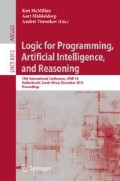Abstract
We describe a framework that combines deductive, numeric, and inductive reasoning to solve geometric problems. Applications include the generation of geometric models and animations, as well as problem solving in the context of intelligent tutoring systems.
Our novel methodology uses (i) deductive reasoning to generate a partial program from logical constraints, (ii) numerical methods to evaluate the partial program, thus creating geometric models which are solutions to the original problem, and (iii) inductive synthesis to read off new constraints that are then applied to one more round of deductive reasoning leading to the desired deterministic program. By the combination of methods we were able to solve problems that each of the methods was not able to solve by itself.
The number of nondeterministic choices in a partial program provides a measure of how close a problem is to being solved and can thus be used in the educational context for grading and providing hints.
We have successfully evaluated our methodology on 18 Scholastic Aptitude Test geometry problems, and 11 ruler/compass-based geometry construction problems. Our tool solved these problems using an average of a few seconds per problem.
Access this chapter
Tax calculation will be finalised at checkout
Purchases are for personal use only
Preview
Unable to display preview. Download preview PDF.
References
Abiteboul, S., Hull, R., Vianu, V.: Foundations of Databases. Addison-Wesley (1995)
Aldefeld, B.: Variation of geometries based on a geometric-reasoning method. Computer Aided Design 20(3), 117–126 (1988)
Bouma, W., Fudos, I., Hoffmann, C.M., Cai, J., Paige, R.: Geometric constraint solver. Computer-Aided Design 27(6), 487–501 (1995)
Buchberger, B.: Applications of Gröbner bases in non-linear computational geometry. In: Janßen, R. (ed.) Trends in Computer Algebra. LNCS, vol. 296, pp. 52–80. Springer, Heidelberg (1988)
Gulwani, S., Korthikanti, V., Tiwari, A.: Synthesizing geometry constructions. In: Programming Language Design and Implementation, PLDI (2011)
Garcia-Molina, H., Ullman, J.D., Widom, J.: Database systems - the complete book, 2nd edn. Pearson Education (2009)
Hong, J.: Proving by example and gap theorems. In: FOCS, pp. 107–116. IEEE Computer Society (1986)
Itzhaky, S., Gulwani, S., Immerman, N., Sagiv, M.: Solving geometry problems using a combination of symbolic and numerical reasoning. Technical Report MSR-TR-2012-8, Microsoft Research (January 2012), http://www.cs.tau.ac.il/~shachar/dl/tr-2012.pdf
Jaffar, J., Michaylov, S., Stuckey, P.J., Yap, R.H.C.: The CLP(R) language and system. ACM Trans. Program. Lang. Syst. 14(3), 339–395 (1992)
Köksal, A.S., Kuncak, V., Suter, P.: Constraints as control. In: ACM SIGPLAN Symposium on Principles of Programming Languages, POPL (2012)
Kondo, K.: Algebraic method for manipulation of dimensional relationships in geometric models. Computer-Aided Design 24(3), 141–147 (1992)
Krötzsch, M., Rudolph, S.: Extending decidable existential rules by joining acyclicity and guardedness. In: Walsh, T. (ed.) IJCAI, pp. 963–968. IJCAI/AAAI (2011)
Nelson, G.: Juno, a constraint-based graphics system. In: SIGGRAPH, pp. 235–243 (1985)
Solar-Lezama, A.: Program Synthesis by Sketching. PhD thesis, University of California, Berkeley (2008)
Wong, W.-K., Chan, B.-Y., Yin, S.-K.: A dynamic geometry environment for learning theorem proving. In: Proceedings of the 5th IEEE International Conference on Advanced Learning Technologies, ICALT 2005, Kaohsiung, Taiwan, July 05-08, pp. 15–17. IEEE Computer Society (2005)
Author information
Authors and Affiliations
Editor information
Editors and Affiliations
Rights and permissions
Copyright information
© 2013 Springer-Verlag Berlin Heidelberg
About this paper
Cite this paper
Itzhaky, S., Gulwani, S., Immerman, N., Sagiv, M. (2013). Solving Geometry Problems Using a Combination of Symbolic and Numerical Reasoning. In: McMillan, K., Middeldorp, A., Voronkov, A. (eds) Logic for Programming, Artificial Intelligence, and Reasoning. LPAR 2013. Lecture Notes in Computer Science, vol 8312. Springer, Berlin, Heidelberg. https://doi.org/10.1007/978-3-642-45221-5_31
Download citation
DOI: https://doi.org/10.1007/978-3-642-45221-5_31
Publisher Name: Springer, Berlin, Heidelberg
Print ISBN: 978-3-642-45220-8
Online ISBN: 978-3-642-45221-5
eBook Packages: Computer ScienceComputer Science (R0)

